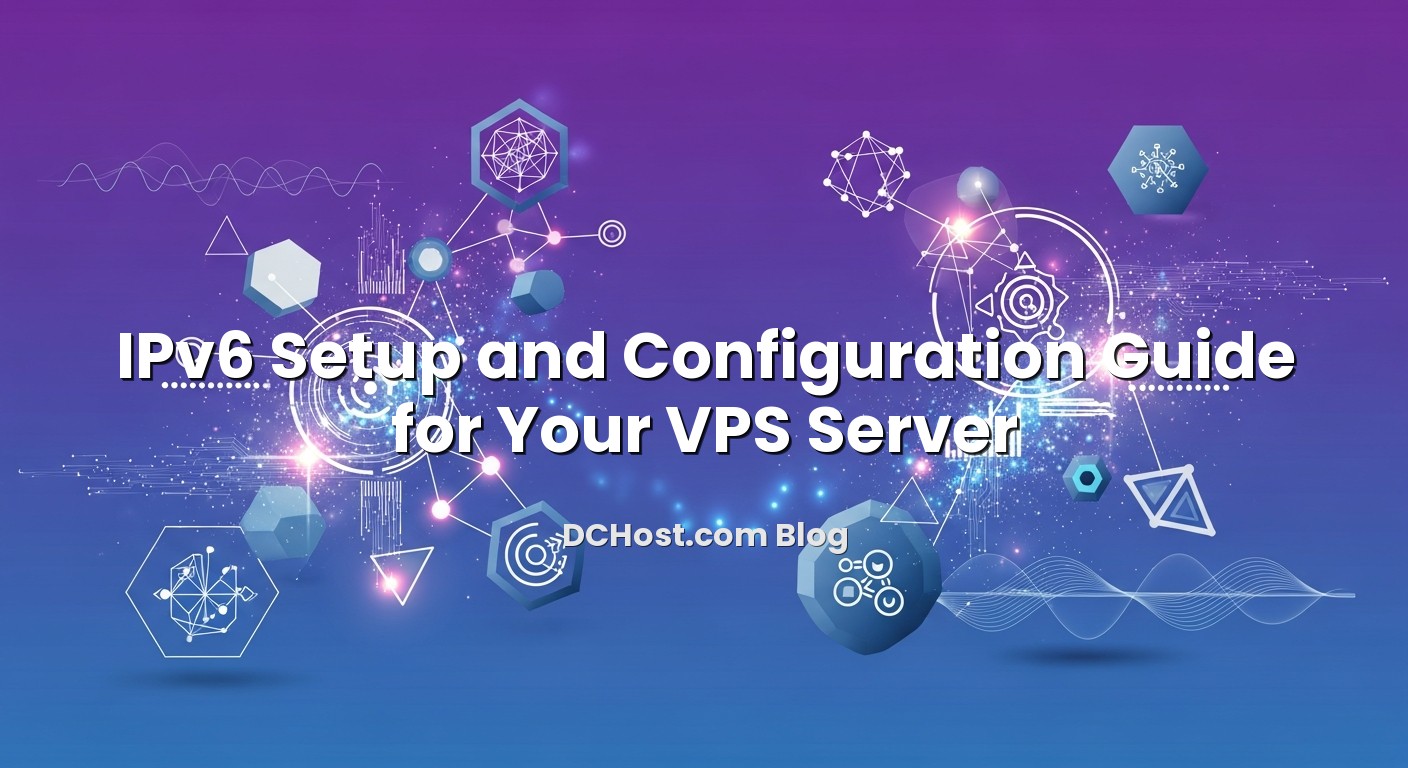IPv6 is no longer an optional “future project” for your VPS; it is quickly becoming a requirement if you want reliable reachability, clean routing, and a hosting stack that will age well. As IPv4 prices climb and more networks (especially mobile and large ISPs) prefer IPv6 paths, enabling it on your VPS is one of those upgrades that pays off quietly every day. In hosting reviews, security audits, and capacity planning meetings with our customers at dchost.com, we keep seeing the same pattern: teams who enabled dual-stack (IPv4 + IPv6) earlier have fewer headaches with routing, fewer surprises with email deliverability, and better flexibility when scaling out. In this guide we will walk through, step by step, how to enable and correctly configure IPv6 on your VPS, test that it really works end-to-end, secure it with a proper firewall, and wire it into your DNS and email stack without breaking anything.
İçindekiler
- 1 Why Enabling IPv6 on Your VPS Matters Now
- 2 IPv6 Basics for VPS Owners: What You Actually Need to Know
- 3 Prerequisites: What You Need Before Configuring IPv6
- 4 Finding Your IPv6 Details in the dchost.com Panel
- 5 Configuring IPv6 on Popular Linux Distributions
- 6 Testing, Troubleshooting, and Common IPv6 Pitfalls
- 7 Securing IPv6: Firewall and Hardening Essentials
- 8 IPv6 and DNS: AAAA Records, Reverse DNS, and Email
- 9 Monitoring IPv6 on Your VPS in Production
- 10 When to Consider IPv6-Only on a VPS
- 11 Summary and Next Steps with dchost.com
Why Enabling IPv6 on Your VPS Matters Now
Before we dive into configs, it is important to understand why you are investing time in IPv6 at all. The short version: IPv4 addresses are scarce and expensive, while IPv6 provides a practically inexhaustible pool of public IPs with cleaner routing and often better performance.
If you have been following our articles on why IPv4 address prices are hitting record highs and global IPv6 adoption, you already know that the industry is steadily shifting. Many ISPs now offer native IPv6, some enterprise networks prefer IPv6-first routing, and modern CDNs and managed DNS services are built with IPv6 in mind from day one.
For your VPS, enabling IPv6 means:
- Better reachability to users on IPv6-only or IPv6-preferred networks.
- Future-proofing for price and availability shocks in IPv4 space.
- Cleaner network design for microservices or multi-region architectures.
- Improved email deliverability when configured correctly, especially as more providers validate IPv6 paths.
The rest of this guide assumes you already have a VPS with IPv6 support from us at dchost.com and want a calm, reproducible way to configure it.
IPv6 Basics for VPS Owners: What You Actually Need to Know
You do not need to become a network engineer to use IPv6 on your VPS, but a few key concepts will make the configuration steps much easier to understand.
IPv6 address format and compression
An IPv6 address is 128 bits, written as eight groups of four hexadecimal digits, separated by colons. Example:
2001:db8:1234:abcd:0000:0000:0000:0001Zeros can be compressed for readability:
- Leading zeros in each group can be omitted:
0001→1. - One continuous run of
:0000:groups can become::.
So the address above becomes:
2001:db8:1234:abcd::1Prefixes and subnets
As with IPv4, IPv6 uses CIDR notation to express networks. On a VPS you will typically see a prefix like /64:
2001:db8:1234:abcd::/64– a network with an enormous number of usable addresses.- Your VPS will be assigned one or more individual IPv6 addresses inside this range.
Dual-stack vs IPv6-only
Most real-world deployments start with dual-stack: your VPS has both IPv4 and IPv6 addresses, and your services listen on both families. This gives you immediate benefits without breaking old IPv4-only clients.
IPv6-only setups are possible and can be very elegant, especially with NAT64/DNS64 bridges. We covered this in detail in our article on running a website on an IPv6-only VPS. For now, assume you are targeting dual-stack.
Link-local and global addresses
Your server will often have:
- Link-local address (starting with
fe80::) – used for communication on the local link only, not routed on the internet. - Global unicast address (e.g.
2a01:4f8:...) – routable on the public internet and what you will configure in DNS.
We will focus on the global address provided by dchost.com in your control panel.
Prerequisites: What You Need Before Configuring IPv6
Before touching configuration files, verify these prerequisites. Skipping this checklist is the most common reason IPv6 “does not work” on a VPS.
1. IPv6 support in your VPS plan
All modern VPS platforms should support IPv6, but you still need to ensure it is enabled for your specific server. On dchost.com this typically means:
- IPv6 is enabled at the data center network level.
- Your VPS has at least one IPv6 address and gateway assigned.
- Security groups/firewall templates have IPv6 rules configured.
If you are not sure, open a ticket with our support team and ask for the IPv6 details for your VPS.
2. Operating system support
Any recent Linux distribution has IPv6 enabled in the kernel by default (Ubuntu, Debian, Rocky Linux, AlmaLinux, etc.). Problems usually come from:
- IPv6 manually disabled via
sysctlparameters. - Old network configuration tools that conflict with newer ones (e.g., ifupdown vs Netplan).
- Firewall rules that allow IPv4 but drop all IPv6 traffic.
3. DNS and control over records
You will need the ability to edit DNS records for your domain so you can add AAAA records and, optionally, IPv6 PTR records for reverse DNS. If you are not fully comfortable with DNS yet, our article explaining DNS records like a friend is a great warm-up.
Finding Your IPv6 Details in the dchost.com Panel
Every provider exposes IPv6 slightly differently, but the ingredients are the same. From your dchost.com control panel, note down:
- Global IPv6 address for the VPS (e.g.
2001:db8:1234:abcd::10). - Prefix length (usually
/64). - Gateway address (e.g.
2001:db8:1234:abcd::1). - IPv6 DNS resolvers (you can also use public resolvers, but using ours can sometimes reduce latency).
We will plug these details into your network configuration files in the next section.
Configuring IPv6 on Popular Linux Distributions
The exact configuration depends on your distro and networking stack. Below you will find common approaches for Ubuntu/Debian and Rocky/AlmaLinux (RHEL clones). Adjust interface names (eth0, ens3, enp1s0, etc.) to match your VPS.
Ubuntu 18.04+ and Debian 10+ with Netplan
Most modern Ubuntu and some Debian images use Netplan with either systemd-networkd or NetworkManager under the hood.
- Find your Netplan config file, e.g.:
ls /etc/netplan/ - Edit the YAML file, for example
/etc/netplan/50-cloud-init.yaml:
network:
version: 2
ethernets:
ens3:
dhcp4: true
addresses:
- 2001:db8:1234:abcd::10/64
gateway6: 2001:db8:1234:abcd::1
nameservers:
addresses:
- 2001:4860:4860::8888
- 2001:4860:4860::8844
Replace the IPv6 address, prefix and gateway with the ones from your dchost.com panel. Keep dhcp4: true if you are still using IPv4 DHCP.
- Apply the configuration:
sudo netplan applyValidate the address on your interface:
ip -6 addr show dev ens3
ip -6 routeDebian with ifupdown (/etc/network/interfaces)
On older Debian or minimal images using ifupdown, you configure IPv6 in /etc/network/interfaces:
auto ens3
iface ens3 inet dhcp
iface ens3 inet6 static
address 2001:db8:1234:abcd::10
netmask 64
gateway 2001:db8:1234:abcd::1
Then restart networking:
sudo systemctl restart networkingRocky Linux, AlmaLinux, CentOS with NetworkManager (nmcli)
On RHEL-like systems using NetworkManager, you can configure IPv6 via nmcli or by editing the ifcfg file.
Using nmcli
nmcli connection showFind your connection name (for example System eth0), then:
nmcli connection modify "System eth0"
ipv6.method manual
ipv6.addresses 2001:db8:1234:abcd::10/64
ipv6.gateway 2001:db8:1234:abcd::1
ipv6.dns "2001:4860:4860::8888,2001:4860:4860::8844"
nmcli connection up "System eth0"
Using ifcfg files
Edit /etc/sysconfig/network-scripts/ifcfg-eth0 (interface name may differ):
DEVICE=eth0
BOOTPROTO=dhcp
ONBOOT=yes
IPV6INIT=yes
IPV6_AUTOCONF=no
IPV6ADDR=2001:db8:1234:abcd::10/64
IPV6_DEFAULTGW=2001:db8:1234:abcd::1
Restart networking or NetworkManager:
sudo systemctl restart NetworkManagerCheck basic IPv6 connectivity
Regardless of distribution, once configured you should verify that you can reach the internet over IPv6:
ping -6 google.com
ping6 ipv6.google.com
curl -6 https://ifconfig.co
If these commands return an IPv6 address for your VPS and show successful pings, your basic network path is live.
Testing, Troubleshooting, and Common IPv6 Pitfalls
Getting an IPv6 address on the interface is only half the story. You also need to confirm routing, DNS, and firewall behaviour.
Verify routing
Check the default IPv6 route:
ip -6 route show defaultYou should see a line similar to:
default via 2001:db8:1234:abcd::1 dev ens3 proto staticIf the default route is missing, your server will only be able to speak to its local link, not the wider internet. Re-check your gateway configuration.
Validate DNS resolution over IPv6
Ensure your resolver can answer over IPv6:
dig aaaa www.dchost.com @2001:4860:4860::8888If queries succeed but normal commands still fail, check /etc/resolv.conf for misconfigured DNS servers.
Check for firewall blocks
A very common problem: the IPv4 firewall rules are carefully tuned, but IPv6 is left in a default-drop state. We will talk about hardening later, but for troubleshooting you can temporarily accept all traffic on IPv6 (only briefly, on a non-production system) to see if the firewall is the issue.
If you are using nftables, our detailed guide on IPv6-aware nftables firewall configuration walks through production-ready rule sets.
Browser and external tests
From your local machine, you can test IPv6 reachability by:
- Visiting online test sites that confirm if your domain and IP are reachable over IPv6.
- Using
curl -6 https://yourdomain.comfrom another IPv6-enabled VPS or workstation. - Running
traceroute6 yourdomain.comto see the hops along the IPv6 path.
Securing IPv6: Firewall and Hardening Essentials
IPv6 does not magically make things more or less secure than IPv4; the same principles apply. What trips people up is forgetting to apply their security model to IPv6 at all.
Apply a dual-stack firewall policy
Whatever you allow over IPv4 (SSH, HTTP, HTTPS, custom app ports), you should explicitly allow over IPv6 and deny everything else. For example, with nftables you can write combined rules that apply to both families.
table inet filter {
chain input {
type filter hook input priority 0;
ct state established,related accept
iif lo accept
tcp dport { 22, 80, 443 } accept
ip6 nexthdr icmpv6 accept # allow essential IPv6 ICMP
reject with icmpx type admin-prohibited
}
}
Note the explicit allowance for ICMPv6; blocking it entirely can break path MTU discovery and neighbour discovery, causing weird and intermittent issues instead of clean failures.
General VPS security
Enabling IPv6 should be part of a broader hardening plan. If you have not already, follow our checklist in how to secure a VPS server to lock down SSH, users, and services. All of those recommendations apply equally to IPv6 addresses.
Application-level configuration
Many services bind only to IPv4 by default. After enabling IPv6, review your configs:
- Nginx/Apache: ensure
listen [::]:80;andlisten [::]:443;(or their equivalents) are present. - Mail servers: configure Postfix/Exim/Dovecot to listen on IPv6 as well as IPv4.
- Databases: only listen on IPv6 if needed; internal DBs may remain on localhost or private IPv4.
IPv6 and DNS: AAAA Records, Reverse DNS, and Email
Once your VPS has working IPv6 connectivity, you need DNS to reflect that, otherwise users will never reach it over IPv6.
Adding AAAA records
For each hostname you want reachable over IPv6 (e.g. example.com, www.example.com):
- Create an AAAA record pointing to your server’s IPv6 address.
- Keep your existing A record so IPv4 users can still connect.
We have a dedicated deep dive on this topic in our no-drama dual-stack AAAA record playbook, including real-world testing strategies.
Reverse DNS (PTR) for IPv6
Reverse DNS for IPv6 is similar to IPv4 but uses the ip6.arpa domain and a more verbose format. In practice, most VPS users simply configure PTR through their provider’s panel:
- Choose the IPv6 address assigned to your VPS.
- Set the PTR / reverse hostname (e.g.
vps1.example.com).
This is particularly important for email servers.
Email deliverability over IPv6
If you run your own mail server, you must be more deliberate with IPv6. Many providers have stricter checks on IPv6-based mail than IPv4. At a minimum:
- Ensure PTR (reverse DNS) for your IPv6 address matches the HELO/EHLO hostname.
- Create appropriate SPF, DKIM, and DMARC records that include the IPv6 address if you intend to send from it.
- Monitor blocklists and reputation for that IPv6 address.
We have a separate, practical guide on this: Email deliverability over IPv6: PTR, HELO, SPF and blocklists. If you plan to send any serious volume of mail, read that before flipping the switch.
Monitoring IPv6 on Your VPS in Production
Once IPv6 is live, you want your monitoring to treat it as a first-class citizen. A surprising number of incidents come from tools that only check IPv4 paths while IPv6 is already broken (or vice versa).
Dual-stack uptime checks
For each critical endpoint, configure:
- At least one probe that resolves and connects over IPv4.
- At least one probe that resolves and connects over IPv6.
This can be done with self-hosted tools or external monitoring services. Our article on VPS monitoring and alerts with Prometheus, Grafana and Uptime Kuma is a good starting point if you want to run this stack yourself on a dchost.com VPS.
Log analysis and observability
Ensure your logging stack correctly parses IPv6 addresses:
- Web server logs should show IPv6 client IPs without truncation.
- WAF and intrusion detection rules should be IPv6-aware.
- Any IP-based rate limiting or abuse detection should support both families.
Many rate-limiting rules in web servers, CDNs, or WAFs were originally written assuming IPv4; audit them for IPv6 compatibility.
When to Consider IPv6-Only on a VPS
After you are comfortable with dual-stack, you might be tempted by IPv6-only deployments. They can be elegant, cost-effective, and future-proof, but they also require more careful planning.
Pros of IPv6-only
- No need to acquire additional IPv4 space for internal services.
- Cleaner network design with vast address space per service or tenant.
- Better alignment with where the internet is heading.
Challenges and mitigation
The main challenge is talking to IPv4-only services (legacy APIs, payment gateways, some email providers). This is where NAT64/DNS64 setups bridge IPv6-only clients to IPv4 destinations. In our detailed story on IPv6-only VPS with NAT64/DNS64, we walk through how to build such a bridge safely.
For most teams, our recommendation is:
- Start with dual-stack for internet-facing services.
- Use IPv6-only for internal microservices or lab environments where you control both ends.
- Plan IPv6-only public deployments only after you are comfortable with the operational model.
Summary and Next Steps with dchost.com
Enabling IPv6 on your VPS is not a dramatic re-architecture; it is a set of calm, reproducible steps: get your IPv6 address and gateway from the dchost.com panel, plug them into your OS network configuration, confirm routing and DNS, mirror your firewall policy for IPv6, and finally expose your services via AAAA records and properly configured reverse DNS. Once that is done, add IPv6-aware checks to your monitoring and treat both IP families as first-class citizens.
From what we see across our customer base, teams who invest a few hours in a solid IPv6 setup now have an easier time scaling later, especially when it comes to multi-region deployments, email deliverability, and cost control around scarce IPv4 space. If you are planning a new project or want to retrofit IPv6 on an existing VPS, you can spin up an IPv6-ready VPS, dedicated server, or colocation setup with us at dchost.com and follow this guide as your runbook.
If you want to go deeper, we recommend reading our dual-stack DNS guide on AAAAs and real-world tests, our IPv6 email deliverability playbook, and the nftables firewall cookbook for IPv6-aware security. And if you prefer to discuss your specific use case, our team at dchost.com is always happy to help you design and deploy an IPv6 strategy that matches your real traffic and growth plans.





